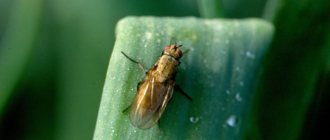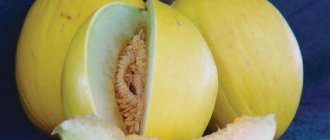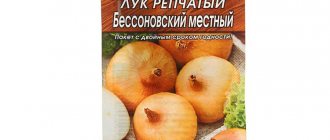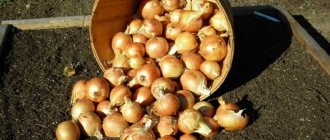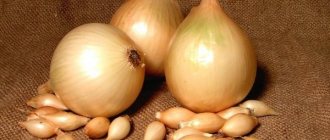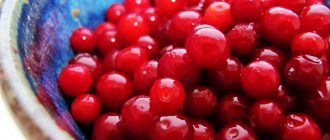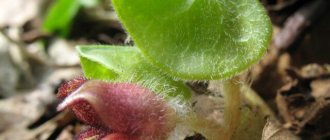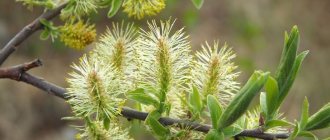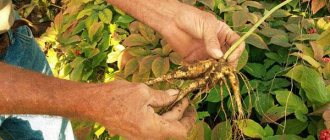Bamberger onions were bred in Holland - breeders managed to obtain a unique type of vegetable with an pungent taste and medium-sized fruits. With its characteristics and properties, Bamberger is superior to most onion varieties. It is easy to grow and care for.
The length of the Bamberger bow reaches 10 cm
Luk Bamberger
Bamberger onions are sweet without strong bitterness
Description
Bamberger attracts attention with its taste characteristics, which are similar to salad varieties.
Appearance
Let's look at the characteristics of the variety in more detail:
- shape – round, elongated;
- fruit sizes are average;
- fruit weight – up to 100 g;
- the length of one head is up to 10 cm;
- pulp color – white;
- husk color – yellow-brown;
- taste – sweet, no pronounced bitterness;
- yield – 6 kg per 1 sq. m;
- Depending on the region of cultivation, it can be early-ripening, mid-ripening and mid-late.
Advantages and disadvantages
Vegetable growers highlight the following advantages :
- unique taste qualities;
- excellent shelf life - can be stored almost until the next harvest;
- convenient bulb shape;
- high level of productivity;
- versatility of use;
- peels off well;
- quite resistant to diseases and pest attacks;
- Suitable for planting in different climatic zones.
But there are also some disadvantages :
- the husks fall off during storage;
- planting material is quite expensive;
- large bulbs can shoot;
- The harvested crop does not tolerate dampness well.
Reproduction methods
There are several ways to propagate this onion:
- Sevcom. You can grow seed material yourself or buy it at a specialty store.
- Vegetative way. In this case, the teeth that form on adult bulbs are used - they are carefully cut off, germinated and planted in the soil.
general characteristics
Bamberger is a mid-early onion variety. It has a sweet, slightly spicy taste. It is for this quality that many people loved him. Bamberger onions are excellent for consumption both fresh and thermally processed.
Description of appearance and photo
Bamberger bulbs have a rounded-oblong shape. The length of the head reaches 10 cm, and the average weight is 80 g. The white juicy pulp is covered with a yellow-brown peel. For its bulbous shape, convenient for cutting and excellent taste, amberger is valued by housewives.
Below you will see a photo of what this bow looks like:
Advantages and disadvantages
Advantages:
- suitability for cultivation in all climatic zones;
- resistance to diseases and pests;
- long shelf life;
- forms few arrows;
- juicy pulp and pleasant taste;
- preservation of taste during long-term storage.
Flaws:
- During storage, the husks may shed;
- with large sowing, the formation of a large number of arrows;
- expensive planting material.
What diseases and pests is it resistant to?
Bamberger has excellent resistance to the following diseases:
- bottom rot;
- powdery mildew.
The variety is most resistant to pests such as:
- thrips;
- onion fly.
Soil requirements
It is important that onion beds are located on small hills and not in lowlands. Stagnation of water in the area can cause onion rot
Taste characteristics
Bamberger onions have excellent taste. The juicy pulp has a pleasant taste, which is characterized by the absence of bitterness and pungency. It is for its taste properties that this variety is very much in demand and loved.
Productivity
The productivity of Bamberger onions is quite high. If agricultural techniques are followed and proper care is taken, the average yield is 5-6 kg per square meter.
Keeping quality
Keeping quality is another quality for which the Bamberger is valued. The neck practically does not rot, and if storage rules are followed, it is perfectly preserved until the new harvest.
It is important that the taste does not change
How do they use it?
Due to the pleasant taste of Bamberger, it is widely used in cooking. The variety is well suited for adding to dishes raw, sauteed, as well as for canning all kinds of salads. Of particular value is the green feather of the turnip, which is rich in vitamins and, in addition to taste, will decorate any dish.
Landing
Before planting Bamberger, read the planting rules - how to prepare the site and the planting material itself.
Conditions
It is best to plant Bamberger onions on sandy loam soils, and choose a place that is well lit and without drafts. This variety is planted before winter or in early spring. If planting is carried out in winter, then select the smallest bulbs.
Also, when growing this variety, follow the rules of crop rotation - in the place where the onion grew, it cannot be planted for 3 years. It is better to select those places where legumes, tomatoes or cabbage grew in previous seasons. An excellent neighbor for Bamberger is carrots.
Soil preparation
Before planting onions, prepare the soil - dig up the soil and add fertilizer, as the soil must have a loose structure with a sufficient amount of nutrients. To do this, follow these steps:
- carry out weeding (to a depth of 2-3 cm);
- remove all weeds;
- if there are more than 5 perennial weeds per 1 square meter growing on your site. m, carry out chemical control against them - use Roundup and Hurricane herbicides (30 ml per one hundred square meters);
- scatter organic fertilizers over the soil surface - rotted manure or compost (from 5 to 9 kg per 1 sq. m);
- a few days after fertilizing, plow the area - the optimal depth is 15-18 cm;
- level the plowed area using agricultural implements - if once was not enough, then repeat the harrowing;
- Divide the prepared soil into holes (the number depends on the scale of planting).
Preparation of seed material
Since there are 2 methods of growing Bamberger, there are also several preparatory features for preparing seed material.
Preparing the sets
Dry the purchased material by placing the bulbs in a warm room. Even if you grew the seed yourself, still warm it up before planting.
Warm up the planting material gradually:
- keep it in a room with an air temperature of about +20 degrees for several weeks;
- a day before planting in the soil, transfer the seedlings to a room where the temperature will be 15-20 degrees higher.
This speeds up the germination of onions and also prevents the appearance of arrows. If you do not have time for such a lengthy process, you can speed it up by dipping the bulbs in hot water for 15-20 minutes before planting in the ground. Also, to accelerate growth, stimulating drugs are used - Rost-1 or Gumisol (instructions for use are on the package).
To prevent diseases and pests, treat the seedlings with a solution of potassium permanganate or copper sulfate, and before planting, check them again to make sure that they are free of various defects - traces of rot, mold, etc.
The set should be dense, golden in color and rustle in your hands. It’s good if all planting material is approximately the same size. The most suitable set size is 2-4 cm. If the size is smaller, the bow will not give the desired result; if it is larger, it may shoot.
Planting seedlings for winter is carried out 20 days before the onset of frost. Furrows 3-4 cm deep are made on the site, and the distance between them is 20-30 cm. The seedlings are planted at intervals of 8-10 cm, after which they are covered with soil and mulched.
Preparing and planting seeds
If cultivation is carried out not by bulbs, but by seeds, then they are also prepared for planting:
- Sort through the seeds, separating out any empty, damaged or rotten ones.
- Before sowing, immerse the seeds in a solution with growth stimulants - take Vympel or Emistim for this. To prepare a solution, just add 5 ml of growth stimulants to 5 liters of water.
- Immerse the seeds in this liquid for 24 hours, and then immediately plant them in previously prepared holes.
When sowing seeds, furrows are made to a depth of 5-7 cm and watered abundantly. The distance between them is 15 cm. Before sowing, put rotted manure (50 g) and superphosphate (10 g) at the bottom of the furrows, after which the seeds are sown to a depth of 2-3 cm (3 g per 1 sq. m). Then fill the finished rows with soil and lightly compact the soil.
Landing dates
In different regions, the timing of planting seedlings differs:
- In Siberia, seedlings are planted in open ground at the end of May. Monitor the temperature before planting - it should be no lower than 8-10 degrees.
- In the Urals, seedlings are planted around mid-May. As in Siberia, wait until the soil temperature is +8-10 degrees.
- The optimal time for planting seedlings for central Russia is mid-April - early May.
Advice from experienced gardeners
Farmer tips for growing Bamberger:
- Cover the soil between the rows with mulch. This will help avoid damage to the bulbs and leaves when cultivating the soil and minimize the risk of developing certain bacterial diseases.
- Cover newly planted plants with agrofibre or spunbond - this will keep them warmer. In addition, the non-woven material hides the smell of onions from pests.
- Plant carrots nearby - they repel onion pests.
Mother goose: how long it lays and how it hatches eggs
Rules of care
Planting onions is not everything. Next, some agrotechnical measures are carried out to ensure that the harvest is successful.
Watering
Watering is carried out throughout the entire period of active growth of the onion, until the turnip is finally ripe. The frequency of watering depends on several factors, but the main one is weather conditions.
Moderation and regularity of watering are important - Bamberger onions need plenty of water 2 weeks after planting. Irrigation is carried out with settled water (5 liters per 1 sq. m). After this, moistening is carried out as the top layer of soil dries.
At first - 2 times a week, then, from mid-summer, the frequency of watering decreases to avoid waterlogging of the soil. It is very important to completely stop watering 2 weeks before harvest.
Loosening
This procedure is carried out so that the plant receives a sufficient amount of oxygen. Loosening is carried out at least once a week.
If you add mulch under the onions, you can do without loosening. Peat, sawdust, and rotted straw are suitable as mulch.
Weeding
Weed as soon as you notice weeds emerging. The main thing in this procedure is the complete removal of weeds before they take root. Weeding depth is 2-3 cm.
Feeding
With the appearance of the first shoots, it is time to fertilize the plant. During the season, feed onions three times according to the following scheme:
- on the 15th day, add a solution of chicken manure at the rate of 10 liters per 1 square meter. m of land;
- after 21 days, apply nitrogen fertilizers at the rate of 2 tbsp. l. urea per 10 liters of water;
- after another 21 days, the soil is watered with potassium supplements (2 tablespoons of superphosphate per 10 liters of water).
Disease and pest control
Onions are quite resistant to diseases. To prevent them and strengthen young individuals, treat them twice with copper sulfate and copper oxychloride. The first time - when the feathers reach a length of 20 cm, and the second time - in mid-summer during the period of active growth.
Bamberger is attacked by the following diseases:
| Disease | Symptoms | Control/Prevention |
| Powdery mildew | It affects bulbs, seed shoots and leaves. It appears in the form of elongated spots on which grayish-purple fluff forms. | Removal of plant residues from previous years of cultivation, correct crop rotation, balanced fertilizing, treatment with fungicides (Topsin 500 SK). |
| Bacteriosis. | The stems develop poorly and wet rot appears at the base. | Do not sprinkle water, use fungicides (Copernico Hi Bio). |
| Yellow dwarfism | A viral disease that appears as yellow stripes on the leaves. The affected leaves lie on the ground, and the bulb remains small and cannot withstand winter storage. | There is no treatment, prevention is the elimination of affected plants, planting healthy planting material, insecticides. |
| Fusarium | A fungal disease that affects roots, bulbs and leaves damaged during field work or by pests. Diseased roots become covered with white spots, the leaves have a slight yellowing. | Use of healthy material, chemical treatment with drugs (Topsin 500 SK) - 5 or 10 g per 10 liters of water. Each plant is sprayed with a solution (0.5 l). |
Also, the Bamberger onion variety can be attacked by the following types of insects or pests:
| Pest | Symptoms | Control/Prevention |
| Nematode | Attacks stems and bulbs, appears in spring. Onions become infected with the nematode through soil or infected seeds. The bulbs remain small, cracked and irregularly shaped. | Correct crop rotation, removal of diseased plants from the site, treatment with Forse 1.5 G (15 kg per 1 ha). |
| Onion fly | It lays eggs in the onion, the larvae of which gnaw holes in the leaves and move to the center of the leaf. The onion dries out and the growth rate decreases. | To combat the pest, early planting of onions is used, as well as spraying with insecticides Diazon (3 g per 1 sq. m) and Borei (10 ml per 10 liters of water). |
| Secretive proboscis. | Insects sitting in the spaces between onion leaves feed on onion juice, causing serious damage to the plants. | They are combated using the drug Mospilan 20 SG (1.5 g per 6 liters of water). |
Growing from seeds to seedlings at home
Using this method, even in cold climates, it is possible to obtain good bulbs even from annual plants. In addition, this method makes it possible to grow a decent harvest even in limited areas.
Seed preparation
To prepare seeds for planting, you need:
- Go through them manually, removing rotten, damaged and empty specimens.
- As a preventative measure, treat the seeds with a weak solution of potassium permanganate by keeping them in the solution for 40 minutes, then rinsing with clean water and drying.
- Keep the seeds in warm water at a temperature of 50°C for 20 minutes, and then lower them into cold water for a minute, thus creating a contrast bath.
- Soak the sorted seeds in water at room temperature for 24 hours, adding growth stimulants to it.
- After 24 hours, remove the seeds from the solution and immediately plant them in pre-prepared holes.
Contents and location
At home, from seeds sown in boxes with soil, you can grow high-quality seedlings on windowsills, and also, if possible, in greenhouses. The main condition for this is good lighting and moderate heat. The soil in which the seeds are sown is of great importance. The best is considered to be a mixture of turf soil with humus in equal proportions. In addition, it is useful to add ammonium nitrate, superphosphate, potassium sulfate, a teaspoon of each substance and half a glass of wood ash to a bucket of soil mixture. Onions, requiring the best possible lighting, do not need high air temperatures.
Seed planting process
The optimal age of seedlings for transplanting them into open ground is about 50 days. We must proceed from this when planting seeds to grow seedlings from them. In this case, the prerequisites are created for its successful survival during transplantation and, as a result, for a good harvest of ripe bulbs.
When planting seeds you should:
- Remember that on average 20 g of seeds are required per square meter.
- Place the seeds every 1.5 cm in grooves spaced 5 cm apart at a planting depth of 1.5 cm.
- After finishing sowing, compact the soil a little and cover it with a cloth. It is convenient to water crops through it without eroding the soil and exposing, or, conversely, without burying the seeds.
- To obtain seedlings in 10-12 days, maintain a constant temperature of 18-20°C.
- When the first shoots appear, remove the fabric.
Seedling care
Caring for newly emerged seedlings is as follows:
- After the first shoots appear, the temperature should be reduced to 10-12°C for five days, and then increased to 15-16°C, but not higher, in order to avoid excessive stretching of the seedlings.
- At night, the temperature should be kept a few degrees lower.
- In warm weather, the supply of fresh air for hardening off seedlings should not be limited.
- Onion shoots usually do not sprout, limiting themselves to thinning if necessary.
- The soil should not be allowed to dry out, so the sprouts should be watered every two days. Otherwise, young bulbs will stop growing and go into a dormant state.
Transplanting seedlings into the ground
The process of transplanting seedlings into open ground proceeds as follows:
The seedlings, which have already acquired four leaves, are prepared for transplanting. To do this, choose cloudy weather or evening. The seedlings need to be watered well beforehand. For seedlings, the roots are shortened to 2.5 cm and a third of the leaves are cut off
To speed up the healing of wounds on the roots, they are dipped in a clay-humus mash. When planting seedlings in beds, it is important not to bury the plant in the ground, immersing only the roots with the bottom there and making sure that the roots are directed straight down. The interval between each seedling should be at least 6 cm, and a space of 25 cm should be left between the rows. Planting is accompanied by watering and compost mulching.
How to harvest and store crops?
After receiving the harvest, your task becomes its preservation. When digging up onions, do not cut off the feather, as it can later be used to tie the vegetable in bunches or weave braids.
As soon as the harvesting is completed, the onion heads are sent to dry in a warm, well-ventilated room. Recommended temperature for drying is +30 degrees. If the weather is nice and sunny, then dry them right outside, placing the heads on a prepared tray.
Before sending the onions to the storage location, each onion is inspected, since if there are at least a few units with rot, this will ruin the entire harvest.
It is recommended to store vegetables in the basement, the temperature there should be +3-10 degrees, and the humidity level should be 70%. If there is no basement, then an insulated and glazed balcony will do.
It is good to store onions in:
- wooden or plastic boxes with holes made;
- wicker baskets;
- cardboard boxes with perforations;
- in mesh bags.
Reproduction methods
This is best done by sevkom. Before sowing, the material is sorted, dried, diseased and rotten bulbs are removed. The sorted material is divided into three groups, according to fractions.
The sets set aside for planting are dried for several days, then warmed up. Before planting, you should also soak the seeds in warm water with the addition of manganese to protect the planting material from diseases. After this, the seedlings are washed and can be considered ready for planting.
Read more: Indeterminate and determinate varieties of tomatoes, difference
Experts assure that the smallest fraction of sowing is best suited for planting, as it produces the highest yields.
The sets set aside for planting are dried for several days, then warmed up. Before planting, you should also soak the seeds in warm water with the addition of manganese to protect the planting material from diseases. After this, the seedlings are washed and can be considered ready for planting.
Reviews
★★★★★
Kristina, 35 years old, Chelyabinsk. I tried to plant the Bamberger variety several times before winter and determined for myself that it was winter onions that ultimately had the best taste.
In general, Bamberger is attractive because it is very unpretentious, produces a good harvest every year and is easy to care for. When I planted him for the first time, I was still completely new to this matter, but I still managed to do it. ★★★★★
Valentin, 42 years old, Yekaterinburg. I tried growing Bamberger for the first time last year and was very pleased.
He noted to himself that, despite its unpretentiousness, it is better not to skimp on fertilizers, and then the harvest will not be long in coming. Hide
Add your review
Bamberger is an unpretentious and sun-loving plant that, with good care, can produce an excellent harvest. Its property of maintaining its presentation and taste for a long time makes it popular among all gardeners who want to harvest a rich harvest from their plot.
0
0
Copy link
Productivity
The taste of Bamberger onions ranges from sweet to mildly spicy. The fruits are juicy, round and elongated, which is why onions are actively used in cooking.
Fresh salads are prepared from Bamberger onions, they are added to various winter preserves and pickled platters with vegetables.
The harvest from this variety is even, uniform, the onions are almost all the same size, about 80 grams each. If the seed was selected correctly, the shooter practically does not throw it away.
Onion harvesting occurs in the middle or early periods: mid-August or early September. The harvest is dried for several days in the sun or under a canopy until the neck dries out and golden scales appear. Then they cut it, leaving a stump of 2-3 cm, and put it in storage boxes.
Golden onion Bamberger
When the soil at the base of the plants begins to crack, this indicates that the bulbs have begun to ripen. From this point on, the use of fertilizers should be stopped. There is no need to hill up this vegetable, since the bulbs ripen better if they are on the surface of the soil. When the onion heads ripen, the leaves will begin to turn yellow and fall off. After a few days, the bulbs can be pulled out of the soil and left on the surface to begin the hardening process.
Important!A damaged onion should be eaten immediately, as it will not store well.
After this, the turnip is shaken off the dried soil and transferred to dry for two weeks under a shed or in a barn. The recommended temperature for storing Bamberger onion crops varies in the range of 3... 10°C, and air humidity is within 70%. It is not recommended to mix the Bamberger variety with other onion varieties during storage; this may reduce storage time. If there is no special storage for vegetables, then these onions can be successfully stored on the loggia.
Ripe onions can be harvested from mid-August. The turnips are dug up and dried under a canopy for a couple of days until the scales turn yellow and the necks dry out.
The onions are sorted, the foliage and roots are trimmed. The sorted harvest is stored in storage.
The Bamberger variety is considered unpretentious to grow. If the planting material was prepared with high quality, the soil composition is suitable in terms of acidity, and proper care is organized, you are guaranteed a harvest.
Useful tips
The development of some bacterial diseases can be provoked by damage to the bulbs or leaves received during cultivation of the soil. You can reduce the likelihood of such damage by filling the row spaces in the onion bed with natural mulch. Mown, slightly dried grass is suitable as mulch. Every two weeks, the mulch layer is renewed by adding new grass, as the previous portion naturally partially decomposes, enriching the soil in the garden bed with nutrients.
The planted bed can be covered with any non-woven material (agrofibre or spunbond). Young plants under cover will be several degrees warmer than in the open air. In addition, agrofibre perfectly masks the smell of onion plantings from crop pests and reliably covers the plants from their invasion.
Did you know? During viral epidemics, onions are widely used due to their antiseptic properties.
Onions can be grown under this light cover throughout the growing season, removing it only for weeding. The spunbond is not removed for watering; it allows water to pass through itself perfectly. Knowing the timing of planting and the rules for caring for Bamberger onions, both a beginner and an experienced gardener will be able to grow an excellent harvest of large and juicy onions without any problems.
Full review of the Bamberger bow
Bamberger onions were bred in Holland - breeders managed to obtain a unique type of vegetable with an pungent taste and medium-sized fruits. With its characteristics and properties, Bamberger is superior to most onion varieties. It is easy to grow and care for.
The length of the Bamberger bow reaches 10 cm
Bamberger onions are sweet without strong bitterness
